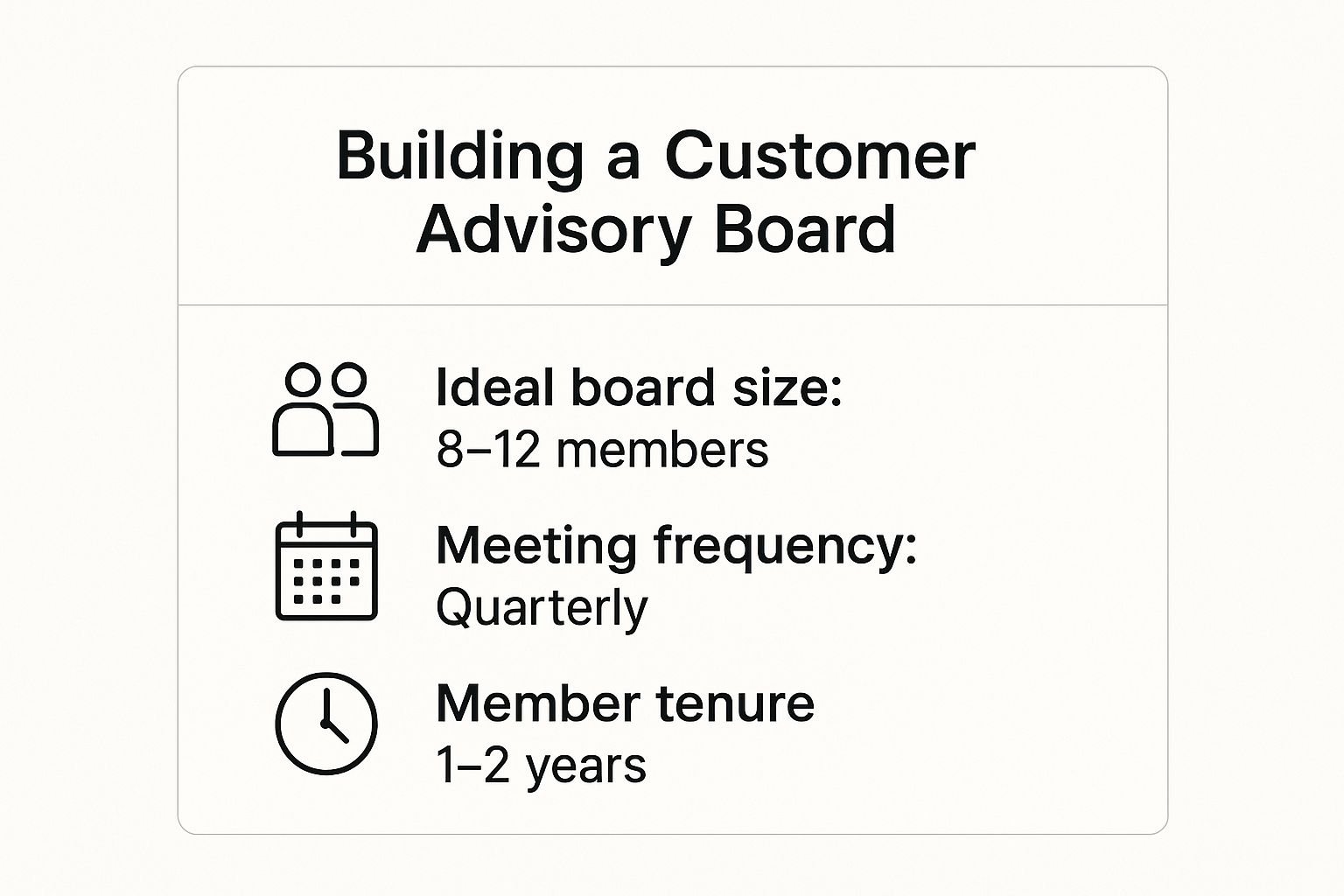A Customer Advisory Board (CAB) is a select group of strategic customers who meet regularly to provide unfiltered guidance on your company’s direction, product roadmap, and overall strategy. For a startup founder, it’s a significant leap beyond basic feedback surveys. A CAB creates a formal, high-level dialogue that validates your vision, pressure-tests your assumptions, and helps you avoid costly missteps on the path to scaling.
Why a CAB Is a Startup’s Secret Weapon for Growth
As an early-stage founder, you’re navigating the path to product-market fit through a fog of conflicting data, noisy analytics, and well-intentioned but biased internal opinions. You're likely running surveys with low response rates or jumping on one-off customer calls that lack strategic depth. A Customer Advisory Board cuts through that noise, giving you a direct line to the people who matter most: your customers.
This isn't just another focus group; a CAB is a genuine strategic asset. It transforms your most insightful customers into dedicated partners who become an extension of your team. They offer perspectives you’d never get internally, challenging your assumptions and illuminating your blind spots. Instead of guessing what the market wants, you get direct guidance on everything from feature prioritization to your competitive positioning.
Beyond Feedback: A Strategic Partnership for Scaling
The true power of a Customer Advisory Board lies in its ability to drive tangible business results, making it a cornerstone of your startup growth strategy. By formalizing this relationship, you gain a significant advantage in several critical areas:
- Roadmap Validation: Imagine presenting your product vision to your ideal users and getting immediate, candid feedback before committing engineering resources. A CAB helps prevent you from building features nobody wants, a common pitfall for early-stage companies.
- Market Intelligence: Your advisors are on the front lines of your industry. They help you uncover emerging trends and competitive threats straight from the source, providing early warnings and highlighting opportunities your team might otherwise miss.
- Customer Loyalty and Advocacy: Inviting a customer to your CAB is a powerful act of validation. It demonstrates that you value their expertise, turning them from users into deeply invested advocates for your brand. This can be invaluable for securing testimonials, case studies, and referrals.
By fostering this sense of partnership, a well-run CAB creates a powerful feedback loop. It aligns your product development directly with market needs, ensuring you build something customers will pay for—and champion.
The financial impact is substantial. According to research from Ignite Advisory Group, companies with mature CAB programs often see a significant ROI. While there are initial costs, a well-executed CAB can lead to a 50% increase in customer retention and reduce time-to-market for new products by up to 30%. This isn't a vanity project; it's a strategic investment that de-risks your roadmap and helps you build a more resilient business.
Setting the Stage for a High-Impact CAB
Launching a Customer Advisory Board without a clear plan is a recipe for wasted time and lackluster results. Before sending a single invitation, you must lay a solid foundation. This groundwork is what transforms your CAB from a simple feedback forum into a strategic engine for growth.
First, define a crystal-clear mission. A vague goal like "getting customer feedback" is insufficient. Your mission must tie directly to your startup's most pressing strategic challenges.

Define Your Core Objective
What is the single most important question your advisors must help you answer? Nailing this down will shape every other decision, from recruitment to agenda planning.
- Exploring new markets? Your objective might be to validate demand in an adjacent industry or geographic region.
- Refining product-market fit? The goal could be to pinpoint the most critical pain points for your ideal customer profile (ICP).
- Navigating a strategic pivot? You’ll need to pressure-test new value propositions with trusted, forward-thinking customers.
This sharp focus prevents meetings from devolving into feature request sessions and keeps the conversation centered on high-value, strategic guidance.
Create a CAB Charter
Once you have a core objective, document it in a formal CAB charter. This internal document serves as your constitution, aligning everyone on the board's purpose and scope. It doesn’t need to be lengthy, but it must be specific.
Your charter is your North Star. It should outline the CAB's mission, the ideal member profile, expected time commitments, and how insights will be captured and acted upon. This document is critical for securing buy-in across your organization.
Gaining this alignment from the start is non-negotiable. Your product, sales, and leadership teams must view the CAB not as a marketing initiative but as a core component of the company's strategic planning process. With a clear charter and unified internal support, you've set the stage for a truly high-impact advisory board that delivers actionable intelligence.
Recruiting Your Dream Team of Advisors
The value of your Customer Advisory Board hinges on who is in the room. A common mistake is simply inviting your biggest or loudest customers. A truly impactful CAB requires a more strategic approach. The goal isn't to fill seats; it's to assemble a diverse council representing key market segments—one that isn't afraid to provide the tough, constructive feedback you need to succeed.
Building this team means looking beyond the obvious candidates. A happy power user is valuable, but an even better member might be a strategic customer from a market you're trying to enter or someone who recently switched to your solution from a major competitor. The right mix of advisors is your best defense against groupthink and the fastest way to uncover critical blind spots.
The key to securing these high-caliber individuals is crafting an invitation that frames membership as a prestigious opportunity, not another time commitment.
Identifying the Ideal Advisor Profile
Your selection criteria should tie directly back to the CAB's mission. You're not just looking for users; you're looking for strategic thinkers within their own organizations.
Look for individuals who are genuinely invested in your success and can think beyond their own feature requests. Are they curious? Do they speak with candor? Do they possess a forward-looking mindset? Evaluating potential members on these qualities is what separates a good CAB from a great one. For more on building an exceptional team, check out our insights on startup team quality.
Founder Excellence Framework: Avoid building a board of "yes-people." The most valuable advisors will respectfully challenge your assumptions and push your thinking. Their role is to provide honest counsel, not just validation.
So, who makes the cut? A clear profile helps distinguish ideal candidates from those who would be a poor fit.
Ideal Customer Advisory Board Member Profile
| Key Attribute to Target | What This Looks Like | Attribute to Avoid |
|---|---|---|
| Strategic Thinker | Sees the big picture; connects your product to their business goals. | Focuses only on minor tactical feature requests. |
| Industry Visionary | Understands market trends and can speak to where the industry is headed. | Has a limited, myopic view of their own company's needs. |
| Constructively Candid | Willing to offer honest, direct feedback, even if it's critical. | Either a "yes-person" or perpetually negative without solutions. |
| Representative Profile | Fits one of your key customer personas or a target market segment. | An outlier whose needs don't represent a larger group. |
| Engaged & Curious | Genuinely interested in your success and asks thoughtful questions. | Is disengaged, distracted, or just there for the networking. |
Ultimately, you want a room full of people who will push you, not just pat you on the back. That is where real breakthroughs happen.
This infographic breaks down core structural metrics for keeping a CAB effective and manageable.

These numbers provide a proven framework. Adhering to them helps ensure your board remains focused, manageable, and consistently infused with fresh perspectives.
Crafting a Compelling Invitation
Once you've identified your ideal candidates, the invitation itself needs to do the heavy lifting. Frame the opportunity not as a favor to you but as something genuinely valuable for them. This is their chance to network with peers, gain a sneak peek at your roadmap, and directly influence the direction of a tool they rely on.
Your outreach should be personal and address these key points:
- A Clear "Why You": Start by explaining the CAB's strategic purpose and why their specific expertise is so valuable to the group. A little genuine flattery goes a long way.
- The Commitment: Be transparent about the time required. For example, state that it involves four 90-minute virtual meetings per year. No surprises.
- The "What's In It For Me?": Explicitly outline the benefits: peer networking, strategic influence on the product, and exclusive insights they won't get anywhere else.
A well-crafted, personalized invitation demonstrates respect for their time and expertise, dramatically increasing the odds of securing the strategic advisors your startup needs to win.
Running CAB Meetings That Spark Real Insight
A great Customer Advisory Board meeting feels less like a corporate presentation and more like a collaborative workshop. Ditch the death-by-PowerPoint mindset. Your goal is to ignite a genuine strategic dialogue, not pitch your latest features. This requires a fundamental shift in how you plan and facilitate these sessions.
The agenda should be built around your biggest strategic questions—not a laundry list of product tweaks. Think bigger. Instead of asking, "What color should this button be?" you should be asking, "How is our industry shifting, and what major challenges will you face in two years that we aren't thinking about yet?"
This framing transforms your advisors from a passive audience into active, engaged partners. It respects their time and expertise, ensuring every session delivers a massive return for everyone involved.
Designing an Agenda for Dialogue
Your agenda is the roadmap to a productive conversation. It must be structured to prioritize interaction and create ample room for healthy debate, ensuring every voice is heard.
A sound framework is the 80/20 rule: 80% of the meeting time should be dedicated to discussion, with only 20% reserved for your presentations.
Here are a few practical tips for building an engaging agenda:
- Send materials in advance. Distribute key documents or thought-provoking questions to members at least a week before the meeting. This allows them to arrive prepared to dive deep.
- Use breakout sessions. For larger CABs, splitting into smaller groups is an effective way to encourage quieter members to speak up and foster more candid, focused conversations on specific topics.
- Facilitate balanced participation. A skilled facilitator knows how to politely intervene when one person dominates the conversation. A simple phrase like, "That's a great point. Now I'd love to hear what others think," can work wonders.
The best CAB meetings uncover uncomfortable truths. As a founder, your job is to create an environment of psychological safety where advisors feel comfortable challenging your assumptions without fear of reprisal.
To elevate your program from ad-hoc meetings to a world-class operation, lean on established best practices. An industry benchmark study by Ignite Advisory Group developed a maturity model for advisory councils across seven key areas. Top-performing programs—about 70% of them—use a formal, structured approach to governance and engagement to drive consistent, high-impact results. You can explore the full CAB maturity model to see how leading companies operate.
From Conversation to Actionable Strategy
The true value of your Customer Advisory Board materializes after the meeting ends. The rich discussion and candid feedback are just potential energy until you translate them into tangible business outcomes. A common startup mistake is treating the CAB meeting as the finish line when it’s really the starting gun for action.
Your first step is to capture and synthesize everything. Do not rely on memory. Meticulously review recordings and notes to identify recurring themes, surprising insights, and points of strong consensus or disagreement. The goal is to distill the raw conversation into a prioritized list of actionable intelligence.

Prioritizing Insights and Closing the Loop
Not all feedback is created equal. Once you've identified key themes, you need a framework for prioritization. This involves aligning advisor insights with your core strategic goals.
Evaluate feedback through these lenses:
- Impact vs. Effort: Which suggestions offer the greatest strategic value for a reasonable amount of resources?
- Strategic Alignment: Does this idea support our current company direction, or does it point toward a pivot we need to seriously consider?
- Urgency: Is this insight tied to a critical market shift or a competitive threat that requires immediate attention?
This prioritization process keeps you focused on what moves the needle. It’s a vital discipline that connects customer feedback to your business strategy. For founders, this is a powerful form of continuous https://spotlightonstartups.com/tag/market-research-for-startups/, keeping you tapped directly into the pulse of your most important market segment.
Now for the final—and most crucial—step: closing the feedback loop. This part is non-negotiable.
Communicating back to your CAB members is what transforms them from temporary advisors into lifelong advocates. Show them exactly how their input is shaping your company's direction. This simple act validates their contribution and cements the CAB's role as a powerful strategic driver.
From Feedback to Action Plan
After each meeting, prepare a concise summary report and distribute it to your members. This isn't just a formality; it’s proof that you were listening.
This report should clearly outline:
- Key Takeaways: A summary of the most important themes and insights from the discussion.
- Decisions Made: The specific actions your team has committed to taking based on their feedback.
- Future Topics: Questions or areas you plan to explore at the next meeting, maintaining momentum.
This structured follow-through demonstrates that you’re not just listening—you’re acting. As industry analysis from sources like TechCrunch often highlights, CABs provide the qualitative insights that quantitative data lacks. A methodical post-meeting process is how you systematically capture that intelligence and integrate it directly into your product and marketing roadmaps.
Founders' Most Common CAB Questions
Even with a solid plan, the practical details of running a Customer Advisory Board can feel overwhelming. Most founders encounter the same questions when getting started. Let's address them directly so you can move forward with confidence.
Should We Pay Our CAB Members?
This is a frequent question, and the short answer is no—at least not with cash. The true value for members comes from strategic influence, networking with peers, and gaining exclusive access to your roadmap.
Monetary compensation can compromise the dynamic. It risks turning a candid, collaborative partnership into a transactional one, which undermines the goal of obtaining honest feedback rather than paid opinions.
Your members should be motivated by the opportunity to shape a product they depend on, not by a stipend. The reward for them is seeing their advice translate into product improvements that make their work easier.
What Do We Do With Conflicting Feedback?
Conflicting feedback isn't a problem; it's a feature. If everyone in the room agrees, you may have assembled a group prone to groupthink. Healthy debate and diverse viewpoints are the entire point of a customer advisory board.
When you encounter conflicting opinions, don't panic. Your role is to facilitate and dig deeper.
- Guide the discussion. Ask clarifying questions to understand the why behind different viewpoints. What is the root cause of the disagreement?
- Look for patterns, not outliers. A single request might be an edge case, but a theme that emerges repeatedly signals a larger strategic opportunity.
- Tie it back to your mission. Always bring the conversation back to the goals outlined in your CAB charter. This helps separate minor tactical ideas from high-impact strategic guidance.
What If a Member Is Disengaged or Disruptive?
It happens. A member who seemed perfect on paper may end up being a poor fit. They might dominate conversations, consistently miss meetings, or fail to contribute meaningfully.
The cleanest way to handle this is to have an exit strategy from the start. This is why setting fixed terms (typically 1-2 years) is crucial. It provides a natural, non-confrontational off-ramp to cycle out members who are not a good fit and bring in fresh perspectives. This keeps your board dynamic and ensures every seat is filled by someone genuinely invested in your success.
At Spotlight on Startups, we explore the strategies and mindsets that set successful founders apart. Our platform delivers actionable knowledge on everything from financial discipline to market validation, providing the clarity you need to move forward with confidence. Learn more at https://spotlightonstartups.com/.